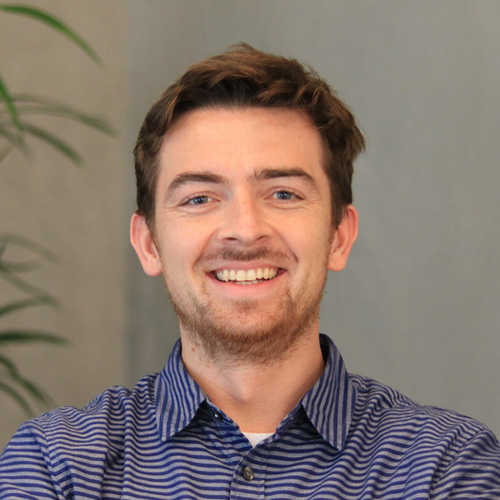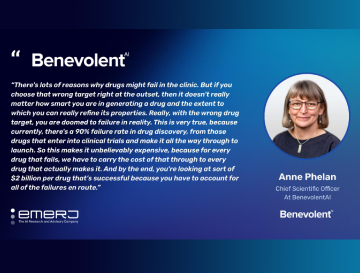 Lead Data Scientist (Visual Analytics), BenevolentAI
Lead Data Scientist (Visual Analytics), BenevolentAI
Combining scientific expertise, computational tools and our AI-enhanced biomedical knowledge graph to successfully uncover a new drug combination for treating a rare brain cancer in children.
In 2018, a multidisciplinary team of BenevolentAI drug discovery scientists and data scientists embarked on a research project to identify potential treatments for children with diffuse intrinsic pontine glioma (DIPG). DIPG is a rare and devastating childhood brain cancer that most commonly occurs in children of around six to seven years of age and has an incidence of around 200-400 per annum in the US. There is a desperate need to find new treatments: the median survival time is approximately nine months from diagnosis, and survival rates have not changed in over 50 years. A quarter of children with DIPG have a mutation in a gene known as ACVR1, yet there remains no approved treatment targeting this mutation. Therefore, we set out to identify a new treatment option for patients who have mutations in the gene ACVR1.
Expert-in-the-loop: using interactive and iterative exploratory tooling to interrogate, strategise and guide towards successful hypotheses
This workflow followed a visual analytics approach; where interactive computational tools applied over an AI-enhanced biomedical knowledge graph were combined with the expertise of our scientists to arrive at a drug combination hypothesis. The Benevolent knowledge graph serves as the data engine for all drug discovery programmes at Benevolent. It contains information extracted from scientific literature using AI-based natural language processing algorithms, in addition to all publicly available biomedical data sources - such as genetics, omics and chemistry data - and is enhanced by internally generated experimental data. The graph powers novel insights about disease and is predominantly used to help discover new drugs for complex multifactorial diseases, however, it is also a powerful resource for drug repurposing for rare diseases, since it leverages such a broad and diverse spectrum of biomedical information.
The process itself leveraged the combined expertise of a multidisciplinary team of data scientists, engineers and drug discovery experts. Computational tools allowed scientists to explore the information in the graph and uncover insights they would not have been able to find using human reasoning alone. The team used a suite of computational tools to query the data in the knowledge graph, to refine their thought processes and to incrementally move closer to the final hypothesis using question-and-answer-tasks.
The approach involved searching for an already approved brain penetrant drug which hit the original targets and had been tested in humans safely. The results revealed the targeted drug vandetanib; vandetanib is approved for treating thyroid cancer and acts against the ACVR1 gene, but has difficulty getting past the blood-brain barrier as it is pushed back out of the brain, resulting in too low of a concentration to have a therapeutic effect. Our scientists worked together with the tools to come up with a seemingly simple, but entirely unconventional question: what if vandetanib could be combined with another drug that inhibited the brain barrier transporter ABCB1, so that the original drug could stay in the brain?
The power of BenevolentAI’s approach for this work lies in enabling scientists to iteratively form and answer questions via expert-augmented computational tooling - by querying the BenevolentAI knowledge graph and visualising and exploring the results. Through this particular approach, scientists uncovered the drug; everolimus, which would allow vandetanib to remain in the brain, and have a therapeutic effect against the tumour.
Collaborating with The Institute of Cancer Research to validate our hypothesis
All too often, precious time, energy, and resources are put into research that is effectively ‘put on the shelf’ if it fails to meet the selection criteria to be carried forward into a company’s pipeline. At BenevolentAI, we are committed to combating these data silos and to sharing data on programmes we have not chosen to advance into our own portfolio. In the case of DIPG, we took our hypothesis to The Institute of Cancer Research, London, for further study.
In research, published in Cancer Discovery on the 23rd September 2021, scientists at The Institute of Cancer Research (ICR), in collaboration with The Royal Marsden NHS Foundation Trust, showed that combining the two drugs increased the amount of vandetanib in the brains of mice by 56 per cent. Researchers at the ICR also found that the treatment extended survival in mice bearing DIPG tumours by 14 per cent compared with those receiving a control treatment. In the study, doctors also tested the drug combination in four DIPG patients.
Vandetanib and everolimus are already approved to treat other types of cancer by NICE, the European Medicines Agency (EMA) and the US Food and Drug Administration (FDA). Researchers at the ICR are hopeful that the drug combination will enter clinical trials in the near future.
Building a use case for expert-in-the-loop workflows
There are notable similarities between the DIPG workflow and the drug repurposing workflow we used to rapidly uncover baricitinib as a COVID-19 treatment in late January 2020 - a drug that was later demonstrated to reduce deaths from COVID-19 in hospitalised patients by 38% in a randomised Phase 3 trial. Both workflows involved scientific experts working directly with data scientists to iteratively explore the diverse data in our AI-enhanced biomedical knowledge graph using computational tools. Both cases bring hope of a new era where human-augmented computational approaches can help scientists to interrogate vast amounts of data to discover new treatment approaches.
The workflow was built and iterated on in response to unique scientific needs, whereby scientists and technologists worked side-by-side, to help both technologists and expert users better understand the problem, and how to arrive at insights. Today, this close collaboration between technologists and scientists continues to form the backbone for all of our drug programmes. What is unique about the workflows, are that they are flexible and iterative in nature - combined with detailed, transparent and interpretable outputs - which make them valuable approaches for our advanced in-house drug discovery programmes. Augmenting human ingenuity in this way represents a powerful new alliance in both drug repurposing and in discovering new drugs for complex multifactorial diseases where the standard of care remains inadequate.
Back to blog post and videos




